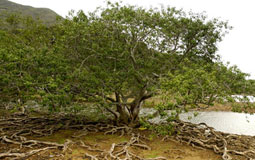 |
| Highly adaptable: Some mangroves develop extensive root systems to help them stablise on soft soil. |


|
One of Nature's many wonders is the ability of plants to adapt and change in hostile environments.
The wetland environment in which mangroves thrive is certainly tough. Water levels fluctuate throughout the day, as does the level of salt in the water. The soil mangroves set their roots into is soft and often lacks oxygen.
Hong Kong is home to eight mangrove species: Aegiceras corniculatum, Kandelia candel, Many-petalled Mangrove, Blind-your-eye, Lumnitzera, Black Mangrove and Looking-glass Tree. Click here for details.
Different species have unique ways of adapting to such a difficult growing environment.
Kandelia candel, Black Mangrove and Many-petalled Mangrove are "viviparous": Their fruits are in the form of a dropper which starts developing into a plant while still attached to the mother plant. It eventually detaches, falling into the soft mud and quickly establishing itself as a new independent plant. This reproduction method is unique in the plant kingdom.
The Looking-glass Tree has silvery white scales on the under side of its leaves. They can reflect bright light and lower the tree's temperature to reduce water loss.
Its fruit has an interesting feature, too.A ridge on its outer edge ensures that young leaves in the fruit face upward and the root faces downward when floating on water. This helps orientate the fruit for development when it reaches land.
The leaves of Aegiceras corniculatum and Avicennia marina have salt glands which help excrete excessive salts the plant has absorbed.
Different root systems inherent in mangroves enable roots to breathe, despite growing in waterlogged soil with low oxygen content. The Many-petalled Mangrove's joints and the Black Mangrove's breathing roots allow for the exchange of gases.
The Aegiceras corniculatum, Kandelia candel and the Looking-glass Tree also have roots that help broaden the tree base to stabilise them in the mudflats.
The Looking-glass Tree is rare among the mangrove species and is found only in Luk Keng, Lai Chi Wo and To Kwa Peng. It usually grows at the back of mangroves, where it occupies a forest fringe or rocky shore. It cannot flourish in exposed or poorly drained sites.
Go To Top
|



